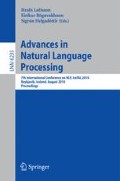Abstract
In this work the random forest language modeling approach is applied with the aim of improving the performance of the LIMSI, highly competitive, Mandarin Chinese speech-to-text system. The experimental setup is that of the GALE Phase 4 evaluation. This setup is characterized by a large amount of available language model training data (over 3.2 billion segmented words). A conventional unpruned 4-gram language model with a vocabulary of 56K words serves as a baseline that is challenging to improve upon. However moderate perplexity and CER improvements over this model were obtained with a random forest language model. Different random forest training strategies were explored so as to attain the maximal gain in performance and Forest of Random Forest language modeling scheme is introduced.
Access this chapter
Tax calculation will be finalised at checkout
Purchases are for personal use only
Preview
Unable to display preview. Download preview PDF.
References
Bahl, L.R., Brown, P.F., de Souza, P.V., Mercer, R.L.: A Tree-Based Statistical Language Model for Natural Language Speech Recognition. CSL 37, 1001–1008 (1989)
Xu, P., Jelinek, F.: Random Forests in Language Modeling. In: Proc. of EMNLP 2004, Barcelona, pp. 325–332 (2004)
Navratil, J., Jin, Q., Andrews, W., Campbell, J.P.: Phonetic Speaker Recognition Using Maximum-Likelihood Binary Decision Tree Models. In: Proc. of ICASSP 2003, Hon Kong, pp. 796–799 (2003)
Xu, P.: Random Forests and the Data Sparseness Problem in Language Modeling. PhD Thesis, Johns Hopkins University, Baltimore (2005)
Su, Y., Jelinek, F., Khudanpur, S.: Large-Scale Random Forest Language Models for Speech Recognition. In: Proc. of Interspeech 2007, Antwerp, pp. 598–601 (2007)
Oparin, I.: Language Models for Automatic Speech Recognition of Inflectional Languages. PhD Thesis, University of West Bohemia, Plzen, Czech Republic (2009)
Oparin, I., Glembek, O., Burget, L., Černocký, J.: Morphological Random Forests for Language Modeling of Inflectional Languages. In: Proc. of IEEE Spoken Language Technology Workshop, SLT 2008, Goa, pp. 189–192 (2008)
Su, Y.: Knowledge Integration Into Language Models: A Random Forest Approach. PhD thesis, Johns Hopkins University, Baltimore (2009)
Luo, J., Lamel, L., Gauvain, J.-L.: Modeling Characters Versus Words for Mandarin Speech Recognition. In: Proc. of ICASSP 2009, Taipei, pp. 4325–4328 (2009)
Wu, D., Fung, P.: Improving Chinese Tokenization with Linguistic Filters on Statistical Lexical Acquisition. In: Proc. of ANLP 1994, pp. 180–181 (1994)
Sproat, R., Chilin, S., Gale, W., Chang, N.: A Stochastic Finite-State Word-Segmentation Algorithm for Chinese. Computational Linguistics 22(3), 218–228 (1996)
Gauvain, J.L., Lamel, L., Adda, G.: The LIMSI Broadcast News Transcription System. Speech Communication 37(1-2), 89–108 (2002)
Lamel, L., Messaoudi, A., Gauvain, J.-L.: Improved Acoustic Modeling for Transcribing Arabic Broadcast Data. In: Proc. of Interspeech 2007, Antwerp, pp. 2077–2800 (2007)
Leggetter, C.J., Woodland, P.C.: Maximum Likelihood Linear Regression for Speaker Adaptation of Continuous Density Hidden Markov Models. CSL 9(2), 171–185 (1995)
Hieronymus, J.L., Liu, X., Gales, M.J.F., Woodland, P.C.: Exploiting Chinese Character Models to Improve Speech Recognition Performance. In: Proc. of Interspeech 2010, Brighton, pp. 367–370 (2010)
Kneser, R., Ney, H.: Improved Backing-off for M-gram Language Modeling. In: Proc. of ICASSP 1995, Detroit, pp. 181–184 (1995)
Schwenk, H., Gauvain, J.-L.: Training Neural Network Language Models on Very Large Corpora. In: Proc. of EMNLP, Vancouver, pp. 201–208 (2005)
Su, Y.: Random Forest Language Model Toolkit, http://www.clsp.jhu.edu/~yisu/rflm.html
Author information
Authors and Affiliations
Editor information
Editors and Affiliations
Rights and permissions
Copyright information
© 2010 Springer-Verlag Berlin Heidelberg
About this paper
Cite this paper
Oparin, I., Lamel, L., Gauvain, JL. (2010). Large-Scale Language Modeling with Random Forests for Mandarin Chinese Speech-to-Text. In: Loftsson, H., Rögnvaldsson, E., Helgadóttir, S. (eds) Advances in Natural Language Processing. NLP 2010. Lecture Notes in Computer Science(), vol 6233. Springer, Berlin, Heidelberg. https://doi.org/10.1007/978-3-642-14770-8_31
Download citation
DOI: https://doi.org/10.1007/978-3-642-14770-8_31
Publisher Name: Springer, Berlin, Heidelberg
Print ISBN: 978-3-642-14769-2
Online ISBN: 978-3-642-14770-8
eBook Packages: Computer ScienceComputer Science (R0)

